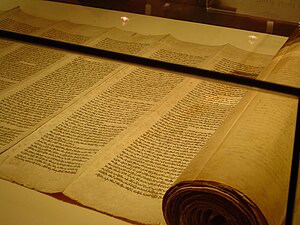 Image via Wikipedia//Sefer Torah scrolls
Image via Wikipedia//Sefer Torah scrollsThe word "chumash" (חומש) comes from the Hebrew word meaning five (Hamesh), and refers to the five books of the Torah. Sometimes, a chumash is simply refers to a collection of the five books of the Torah, but according to the daily practice, it contains the entire first five books, divided up by the weekly parshiyot, with the haftarah portion inserted after each week's parshah. A more formal term is Ḥamishah Ḥumshei Torah, "five fifths of the Law".
In early scribal practice there was a distinction between a Sefer Torah, containing the entire Pentateuch on a parchment scroll, and a copy of one of the five books on its own, which was generally bound in codex form, like a modern book, and had a lesser degree of sanctity.
In the legal codes, such as Maimonides' Mishneh Torah, it is laid down that any copy of the Pentateuch which does not comply with the strict rules for a Sefer Torah, for example because it is not a parchment scroll or contains vowel signs, has only the same sanctity as a copy of an individual book (ḥomesh). In this way, the word ḥomesh (or ḥumash) came to have the extended sense of any copy of the Pentateuch other than a Sefer Torah.
.

No comments:
Post a Comment